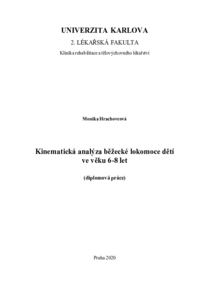Kinematická analýza bežecké lokomoce dětí ve věku 6-8 let
Kinematic analysis of running in children aged 6 to 8 years
diplomová práce (OBHÁJENO)

Zobrazit/
Trvalý odkaz
http://hdl.handle.net/20.500.11956/121780Identifikátory
SIS: 200426
Kolekce
- Kvalifikační práce [1914]
Autor
Vedoucí práce
Oponent práce
Pokorný, Jan
Fakulta / součást
2. lékařská fakulta
Obor
Fyzioterapie
Katedra / ústav / klinika
Klinika rehabilitace a tělovýchovného lékařství
Datum obhajoby
8. 6. 2020
Nakladatel
Univerzita Karlova, 2. lékařská fakultaJazyk
Čeština
Známka
Výborně
Klíčová slova (česky)
běh, děti, biomechanika, kinematická analýza, videoanalýzaKlíčová slova (anglicky)
run, children, biomechanics, kinematic analysis, videoanalysisTato diplomová práce se zabývá biomechanikou běhu a kinematickou analýzou postury dětí ve věku 6 - 8 let při běhu. Práce se skládá ze dvou částí. První teoretická část je zpracovaná formou rešerše. Zabývá se biomechanikou běhu, vývojem běhu, vlivem biomechaniky běhu na vznik běžeckých zranění a popisuje kinematickou analýzu běhu. K vytvoření rešerše byla použita odborná literatura a odborné články získané z databází PubMed, ScienceDirect a zdrojů Národní lékařské knihovny a Univerzity Karlovy. Druhá část je věnována experimentu. Žáci prvních tříd základních škol byli snímáni při běhu spontánní rychlostí dvěma kamerami. Získaný videozáznam byl rozměřen pomocí programu Kinovea 0.8.12. Byly detekovány tři snímky stojné fáze (moment došlapu, moment vertikály a moment toe-off), ze kterých byly analyzovány vybrané úhly v sagitální rovině. Tyto úhly byly v rámci výběrového souboru popsány pojmy deskriptivní statistiky. V rámci souboru byly podleurčitých znaků vybrány podskupiny, jejichž kinematické parametry byly srovnávány pro zjištění statisticky významných rozdílů. V diskuzi jsou srovnávány získané hodnoty s hodnotami, které jsou uváděny v odborných článcích a jsou nabízeny návrhy pro další zkoumání.
This diploma thesis deals with the biomechanics of running and the kinematic analysis of running in children aged 6 - 8 years. The paper consists of two parts. The first part deals with the biomechanics of running and its development, running injuries and describes the kinematic analysis of running. The PubMed, the ScienceDirect Database and sources of the National Medical Library and of the Charles University were searched for creating this theoretical part. The second part describes the experiment - methods and its results. 70 children were recorded during overground running at spontaneous speed. The obtained video recording was measured using the Kinovea 0.8.12. program. The video was scrolled through frames and three moments of the stance phase (initial contact, midstance and moment toe-off) were detected. At these moments selected angles in the sagittal plane were analyzed. These angles were described in the terms of descriptive statistics. Certain characteristics subdivided the cohort into two groups. These were compared in kinematic parameters to determine statistically significant differences. The obtained values from the experiment are discussed and compared with the the values from the recent literature dealing with kinematics of running. At last the suggestions for further research are...
